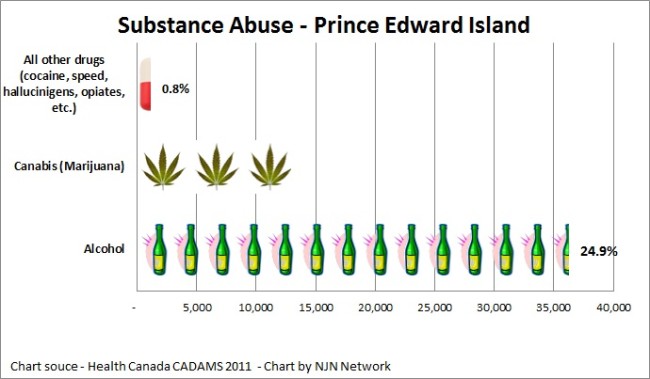The past two weeks has seen the PEI Health Minister clutching at the pain-killer abuse story with the local media parroting his words

Substance abuse on PEI – alcohol tops the list with marijuana 2nd and all other illicit drugs a distant 3rd
According to PEI’s Minister of Health and the local media, Prince Edward Island has a “painkiller epidemic“ but it just ain’t so.
We do know is that if the Province makes it harder to get prescription pain killers PEI’s 25,000 persons living with disabilities will suffer. Pain is the one of the most significant problems for the disabled.
Abuse of opiate based painkillers by Islanders is about average for Canada, and lower than the neighboring province of Nova Scotia. 9.8% of Islanders use marijuana and other illicit drugs. 14.1% of Nova Scotians use illicit drugs and the national average is 9.9%. Table 2: Main 2011 CADUMS indicators by province – Drugs
In fact, harms from abuse of all illicit drugs was down 35% from 2010 to 2011. “A statistically significant decline was seen in psychoactive pharmaceutical use between 2011 (22.9%) and 2010 (26.0%), which was driven by a statistically significant decrease in the use of opioid pain relievers to 16.7% in 2011 from 20.6% in 2010.” Use and Abuse of Psychoactive Pharmaceutical Drugs
Where are these erroneous and shocking stories about pain-killer abuse originating?
The Canadian provinces and federal government cooperate on tracking substance abuse in Canada under CADUMS, The Canadian Alcohol and Drug Use Monitoring Survey (see endnote). Some might question the accuracy of the survey but I would think considering the anti-drug position of the Harper government, the report is more likely to overstate the problems.
CADUMS groups substance abuse into three categories: abuse of alcohol, marijuana use and other illicit drugs, which include cocaine/crack, speed, methamphetamine/crystal meth, hallucinogens, ecstasy, salvia, and heroin. Opiate pain killers are lumped in with heroin which has the lowest abuse. Abuse of pain killers is statistically insignificant, less than 1%.
Where is PEI’s substance abuse? The number one substance abuse is alcohol which is abused by 25% of the PEI population. 8.9% of Islanders like to toke marijuana in 2011. Only .8% of Islanders use any of the other illicit drugs.
Alcohol abuse leads the pack with 23.9% or 36,000 Islanders reporting alcohol consumption above safe levels on an acute or chronic basis. Surprising as it seems, PEI is about average for alcohol abuse. Table 7: Main 2011 CADUMS indicators by province – Alcohol
Cannabis was use in 2011 by 8.9% of the population, which is close to the national average of 9.1% of Canadians using pot or marijuana. Or course, there are many who say marijuana is safe: others say it harms growth of thinking in young people. Table 2: Main 2011 CADUMS indicators by province – Drugs

At the bottom of the list, but distracting Health Minister Doug Currie, CBC and The Charlottetown Guardian is the “other illicit drugs” group which affected 1,100 Islanders in 2011.
Opiate pain killers are the smallest part of that group but the one Minister Currie wants to crack down on. What’s the logic?
Are the Health Canada numbers accurate? I can’t say but the Province of PEI did sign off on CADUMS so they must agree.
I’ve been down this road before: when we pointed out that only 1,100 out of 22,000 Islanders with disabilities were getting Disability Supports, the Deputy Minister told me the federal numbers were not accurate.
“Figures can lie and liars can figure.” When people start playing fast and loose with statistics by ignoring the facts I lose interest in the double speak. Just saying.
Harms from substance abuse
Substance abuse is a serious societal problem in North America. CADUMS reports that negative consequences of alcohol and drugs abuse include harms to: “physical health; friendships and social life; financial position; home life or marriage; work, studies, or employment opportunities; legal problems; difficulty learning; and housing problems.”
The root causes are not always obvious but interdiction of illicit substances is a failed strategy.
People who abuse alcohol and drugs have an illness and should not get a criminal record for possession. Prohibition did not work in the 1920s and 1930s. The American style war on drugs is a complete and expensive failure, only serving to incarcerate minorities.
CADUMS The Canadian Alcohol and Drug Use Monitoring Survey (CADUMS) is an ongoing general population survey of alcohol and illicit drug use among Canadians aged 15 years and older, that was launched in April 2008. Derived from and similar to the Canadian Addiction Survey (CAS) of 2004, CADUMS was designed to provide detailed national and provincial estimates of alcohol and drug-related behaviours and outcomes. The following report presents results from the fourth annual CADUMS data collection which commenced in February 2011.

Be the first to comment